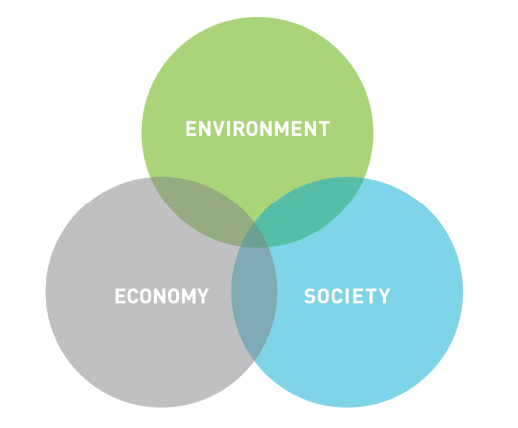Dimensions of Sustainability
The notion of ‘sustainability’ emerged in The Ecologist’s A Blueprint for Survival, in 1972. The quest to make modern civilization ‘sustainable’ inspired the UN’s Stockholm Conference in 1972 and the ‘global trusteeship’ of subsequent international environmental treaties. A popular method of considering the sustainability as state of mind is the triple bottom line approach which makes an attempt at understanding the connections between the environment, society and the economy.
Dimensions of Sustainability
In 2000, the Earth Charter broadened the definition of sustainability to include the idea of a global society “founded on respect for nature, universal human rights, economic justice, and a culture of peace.” The 2005 World Summit on Social Development identified sustainable development goals, such as economic development, social development and environmental protection. Consequently, the three pillars or dimensions of Sustainability came up as:
- Environmental Sustainability
- Social Sustainability
- Economic Sustainability

Environmental Sustainability
Ecological integrity is maintained, all of earth’s environmental systems are kept in balance while natural resources within them are consumed by humans at a rate where they are able to replenish themselves.
Social Sustainability
A socially sustainable society is one in which all members have equal rights, all share equitably in societal benefits, and all participate equally in the decision-making process. Universal human rights and basic necessities are attainable by all people, who have access to enough resources in order to keep their families and communities healthy and secure.
Economic Sustainability
Economic sustainability takes into account the social and ecological consequences of economic activity. It incorporates new paradigms like circular economy, cradle to grave etc. Additionally, economic sustainability also means that human communities across the globe are able to maintain their independence and have access to the resources that they require, financial and other, to meet their needs.
Alternate Perspectives
A common method of visualizing the pillars of sustainability is a Venn diagram, with each circle representing one of the three primary pillars. However, a more-accurate depiction of sustainability is achieved by using concentric circles to symbolize the pillars, with the most important aspect, the Environment, represented by the outer circle.

The Environment is of primary importance because a healthy ecosystem is required to nourish a robust society. Consequently, Society and Social Responsibility are of secondary importance. Economic Sustainability is third because a prosperous Economy cannot exist without a healthy and just society.
Recent Approaches to dimensions of Sustainability
More recently, using a systematic domain model that responds to the debates over the last decade, the Circles of Sustainability approach distinguished four domains of economic, ecological, political and cultural sustainability. This approach outlined in the Agenda21 specifies culture as the fourth domain of sustainable development. The model is now being used by organizations such as the United Nations Cities Programme and Metropolis.

Seven modalities
Another model suggests humans attempt to achieve all of their needs and aspirations via seven modalities: economy, community, occupational groups, government, environment, culture, and physiology. From the global to the individual human scale, each of the seven modalities can be viewed across seven hierarchical levels. Human sustainability can be achieved by attaining sustainability in all levels of the seven modalities.
Credits:
- Featured Image by Chris Barbalis on Unsplash



One thought on “Dimensions of Sustainability”